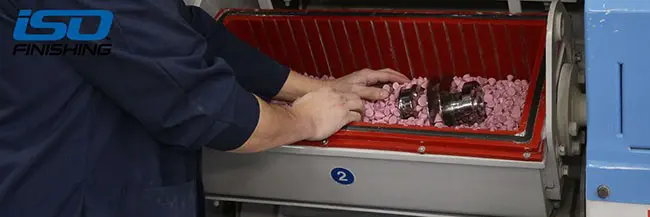ISO Finishing’s skilled engineers and technicians have the experience and expertise to determine the most effective process for the specific type of finish your parts require, but what is mass finishing and how does it relate to deburring? The act of deburring is removing burrs that oftentimes simultaneously improves the finish, hides scratches, nicks, and dings. It also includes other steps like completing the necessary documentation and paperwork, removing stains and discoloration. Deburring really means more than just removing the burr, it encompasses the complete surface finishing process including edge finishing.
Mass finishing allows for the mechanical finishing of many parts simultaneously. In addition to deburring, mass finishing can also be used to descale, brighten, and polish parts. Mass deburring is considered a ‘loose-abrasive’ method in which batches of parts are vibrated or tumbled in specifically designed tubs or barrels along with an abrasive media. Deburring media can be produced from organic, and preformed metallic, ceramic, or resin-bonded plastic materials. Preformed media ranges in a variety of sizes and shapes. In addition to the media, mass finishing usually employs water or other water-soluble compounds.
What are Different Methods of Mass Finishing and Mass Deburring?
There are a few different mass finishing techniques used to achieve a high-quality surface finish, including blasting, lapping, and electropolishing. ISO Finishing uses vibratory deburring machines and centrifugal barrel deburring machines (high energy).
Vibratory deburring and finishing is the most common mass finishing method. With a vibratory deburring machine, a manufactured part is submerged into a bowl or tub along with abrasive media (small abrasive pellets often made of ceramic, plastic, steel or other synthetic material) and water. Eccentric weights mounted on a vertical shaft create vibrations, creating a rolling motion which causes the finishing media and parts to scrape against each other producing a polished surface. The vibration frequency can range from 800 to 3600 vibrations per minute. The millions of unique impressions of the abrasive media on the part produces the smoothing effect on the surface.
Centrifugal barrel finishing uses the same media as in the vibratory deburring process. Parts and abrasive media are loaded into one of four barrels mounted to a center hub, much like a ferris wheel. A centrifugal barrel deburring machine is typically comprised of two or four barrels horizontally mounted between two main drive turrets. As the two main turrets rotate the barrels rotate in the opposite direction of the turret.
Each barrel is loaded with abrasive deburring media and components from 50% to 90% full. During the process, the rotation of the turrets creates a centrifugal force on the media and parts inside each barrel. This force tightly compacts the load and the counter rotation of the barrel causes the deburring media and workpieces to slide against each other. Rapid rotation of the barrels increases the G-forces on the media to create a uniform, non-directional isotropic finish. Centrifugal processing is able to achieve superior surface finishing more quickly and without the use of chemicals.
So Which Deburring Process is Best – Vibratory Deburring or Centrifugal Barrel Deburring?
Centrifugal barrel deburring is typically used on parts where heavy deburring is required. The barrels of centrifugal barrel deburring machine is ideal for heavy loads. Dry tumbling is used when delicate deburring is called for to produce a smooth finish. Wet barreling is used for metal processing to remove excess material as well as to provide a polish.
In a vibratory deburring machine, the process is precise and can deburr even the slightest niches or alcoves in the parts. This makes this process great for delicate and intricate components. This process can also be used on large surfaces because the deburring machine can process with very short strokes and high speeds. These machines can be automated quite easily compared to tumblers.
Both deburring processes are highly customizable based upon the desired finish. ISO Finishing’s skilled engineers and technicians have the experience and expertise to design the most effective process and deburring service for the specific type of finish your parts require.
In short, there is no easy answer to the question, “Which is best?” The unique requirements of the job must be studied and the characteristics of the performance of each system must be known. Through our many years of experience, we have the knowledge and skills to make the determinations necessary.
ISO Finishing focuses on the mass finishing process. ISO Finishing provides complete finishing services for all major markets including aerospace/aviation, automotive/performance motorsports, defense/military, dental, firearms, medical, OEM, pharmaceutical, and plastic industries. Through our work with various titanium, stainless, silicone and polymer alloys, we have developed and documented mass deburring processes designed to ensure each finished part exceeds the most demanding requirements. We have learned that using finishing equipment effectively can only be gained by actually working with the equipment. By keeping detailed records of each and every run we have the confidence in our ability to deliver the best recommendations and services for any market.
Do you offer free sample processing?
Yes, we do! Just give us a call or fill out the Free Sample Request Form. You can send a few samples to finish. We will provide you with options and partner with you to help determine the best process needed for the surface finish your part requires.


